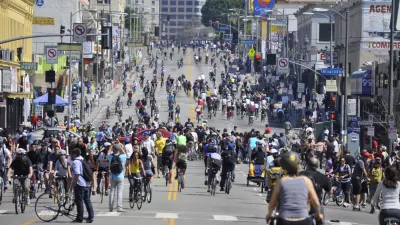NRDC land use expert Amanda Eaken blogs about the approval by the Air Resources Board of the regional targets required by SB 375 to reduce global warming caused by transportation. An overlooked result may be the new powers resting with MPOs.
Amanda Eakin participated in the SB 375 Regional Targets Advisory Committee that provided "recommendations on factors to be considered and methodologies to be used in the ARB target setting process". She is considered one of the authorities on SB 375 process.
"Now that the Air Board has set the targets, the regional agencies will use their existing regional transportation planning processes to select the strategies most appropriate to their regions to meet their targets.
Toward the end of the discussion, CARB Boardmember and Mayor of Riverside Ron Loveridge commented on what may be one of the most significant impacts of law to date:
"The 21st Century is a century of regions. SB 375 is the first time in my political lifetime that we've had a serious regional conversation about urban form."
From San Francisco Chronicle:
"The board adopted different targets for different areas of the state, with the first coming in 2020 and the second in 2035. For the Bay Area, the targets are a 7 percent reduction by 2020 and a 15 percent reduction by 2035.
The targets adopted by the board for the Los Angeles region were higher than the planning body there had called for, though the numbers will be re-evaluated. Officials with the Southern California Association of Governments had asked for a 6 percent reduction by 2020 and 8 percent by 2035, but the air board approved 8 percent by 2020 and 13 percent by 2035."
Thanks to Climate Plan
FULL STORY: California Air Board Votes to Cut Traffic and Clean the Air

Planetizen Federal Action Tracker
A weekly monitor of how Trump’s orders and actions are impacting planners and planning in America.

Congressman Proposes Bill to Rename DC Metro “Trump Train”
The Make Autorail Great Again Act would withhold federal funding to the system until the Washington Metropolitan Area Transit Authority (WMATA), rebrands as the Washington Metropolitan Authority for Greater Access (WMAGA).

The Simple Legislative Tool Transforming Vacant Downtowns
In California, Michigan and Georgia, an easy win is bringing dollars — and delight — back to city centers.

The States Losing Rural Delivery Rooms at an Alarming Pace
In some states, as few as 9% of rural hospitals still deliver babies. As a result, rising pre-term births, no adequate pre-term care and "harrowing" close calls are a growing reality.

The Small South Asian Republic Going all in on EVs
Thanks to one simple policy change less than five years ago, 65% of new cars in this Himalayan country are now electric.

DC Backpedals on Bike Lane Protection, Swaps Barriers for Paint
Citing aesthetic concerns, the city is removing the concrete barriers and flexposts that once separated Arizona Avenue cyclists from motor vehicles.
Urban Design for Planners 1: Software Tools
This six-course series explores essential urban design concepts using open source software and equips planners with the tools they need to participate fully in the urban design process.
Planning for Universal Design
Learn the tools for implementing Universal Design in planning regulations.
Smith Gee Studio
City of Charlotte
City of Camden Redevelopment Agency
City of Astoria
Transportation Research & Education Center (TREC) at Portland State University
US High Speed Rail Association
City of Camden Redevelopment Agency
Municipality of Princeton (NJ)





























